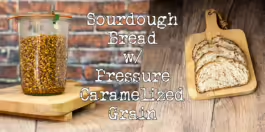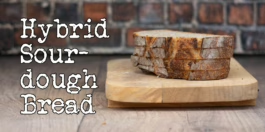Jewish Rye Bread is famous all over the world. Nowhere in the world does it have the same iconic status as in New York City. Every delicatessen and sandwich shop serves its delicious sandwiches on Jewish rye bread. While these loaves of bread are delicious, they often miss the mark regarding the depth of flavor you get from a long fermentation. I created my version of this iconic bread, using a sourdough starter as leavening, with a long cold fermentation to tease out all those delicious tastes hidden in the grains. This is my recipe for Jewish sourdough rye.
A cousin of the Jewish rye bread is the Swedish limpa, a sweeter type of bread. They do love their syrup in Sweden.
If you are just here for the recipe, you can press the button underneath to be automagically transported to the recipe:
Jump to Recipe Jump to VideoThe history of Jewish rye bread
Rye was one of the first cultivated grains. Scholars believe that farmers domesticated rye around 1,000 BCE. The higher classes didn’t consider rye the best food, and the “large, unwashed masses mainly consumed it.” The first written records on rye cultivation were by the Roman naturalist Pliny, the Elder, around 77 BCE. He noted that it was “very poor food and good only to avert starvation.”.
The rye flour itself has a pretty mild flavor. Pairing it with a sourdough starter brings out more of the sour notes people crave. The Jewish bakers would often add caraway seeds or nigella seeds to the rye bread, which is what Americans often associate with the taste of rye bread.
The two types of rye bread prominent in Europe were the kornbrot (Korn being the Yiddish word for rye) and the schwartzbrot (the black bread).
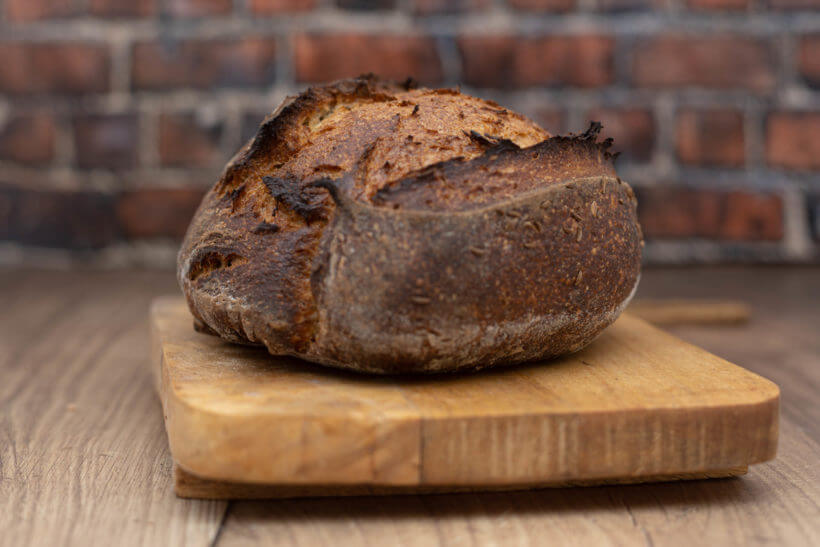
Schwartzbrot is the type of rye bread we eat here in Denmark. Kornbrot contains more wheat flour, whereas schwartzbrot contains mainly rye flour. The difference is in how much wheat flour bakers put in the bread.
Kornbrot was brought to the States by Jewish immigrants and closely resembled was Jewish bakeries make now. The big difference is that those loaves of bread are usually baked using commercial yeast and fermented much faster.
With this bread recipe, we’re returning to the roots and fermenting the bread with a sourdough starter. You can use any starter, though. Using a rye starter will make for an even tastier bread.
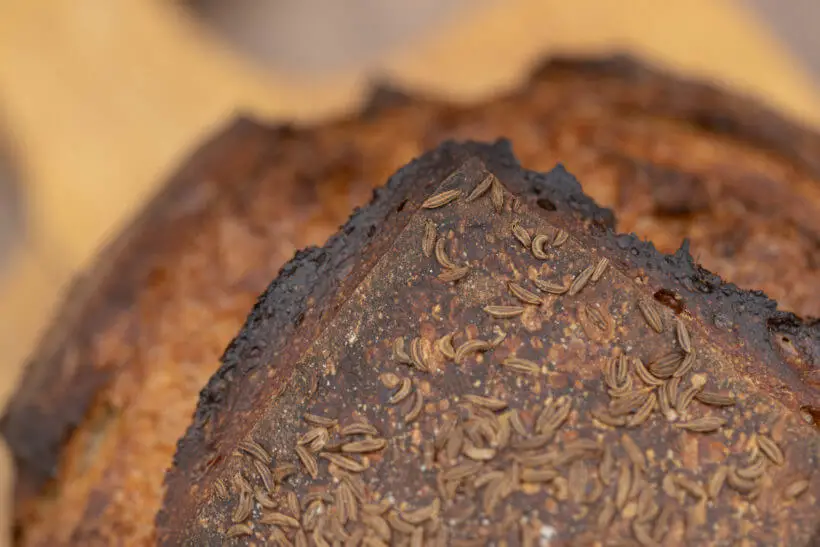
The dough in this Jewish sourdough rye recipe
Vitals
| Total weight | 1542 grams |
| Pre-fermented flour | 9.1% |
| Hydration | 70% |
| Yield | Two small loaves |
The dough
The flour choices for this bread are as follows: 65% bread flour for structure and gluten power; since there’s a significant amount of rye in this bread, you should use strong bread flour. 25% light or white rye for excellent rye taste, but still a tender crumb. 10% whole grain rye flour boosts the rye flavor and a bit of texture.
The inoculation is 20%, and the salt content is 2%, which is very common.
The amount of barley malt syrup is 2.5% for some outstanding malted notes, which works well with the rye taste.
We add 1.3% caraway seeds to the dough. If you like the taste of caraway seeds, you can easily double this.
| Weight | Ingredient | Baker's Percentage |
|---|---|---|
| 520g | bread flour | 65% |
| 200g | light rye flour | 25% |
| 80g | whole-grain rye flour | 10% |
| 536g | water | 67% |
| 160g | starter (100% hydration) | 20% |
| 20g | malt syrup | 2.5% |
| 16g | salt | 2% |
| 10g | caraway seeds | 1.3% |
If you want to play around with the formula, change quantity, hydration, and inoculation, you can do so here in my Bread Calculator.

I don’t have/can’t get barley malt syrup. Can I make a substitute?
You can create a good taste substitute if you cannot get barley malt syrup.
Combine 125g/1 cup of dark ale and 125g/1 scant cup of dark brown sugar in a pot. Bring it to a boil, and then let it simmer uncovered until you have a very thick syrup. `You can use this syrup in place of barley malt syrup.
Stored in the fridge, it stays good indefinitely.
The conclusion of this Jewish sourdough rye recipe
You are in for a treat if you mostly eat wheat-based sourdough loaves of bread. This bread has a great flavor profile. Excellent rye taste, a distinct sourness, the mild anise notes and earthy notes from the caraways seeds, and the malted notes from the barley syrup.
It’s just the perfect storm of flavors coming together to create something more prominent than the sum of the parts.
The crust is super crunchy, and the crumb is soft and moist.
The flavor pairs well with meats and cheeses but is also perfect all by itself or just accompanied by a wonderfully thick layer of butter.
If you’re into excellent tasty artisanal sandwiches, this is the bread for you.
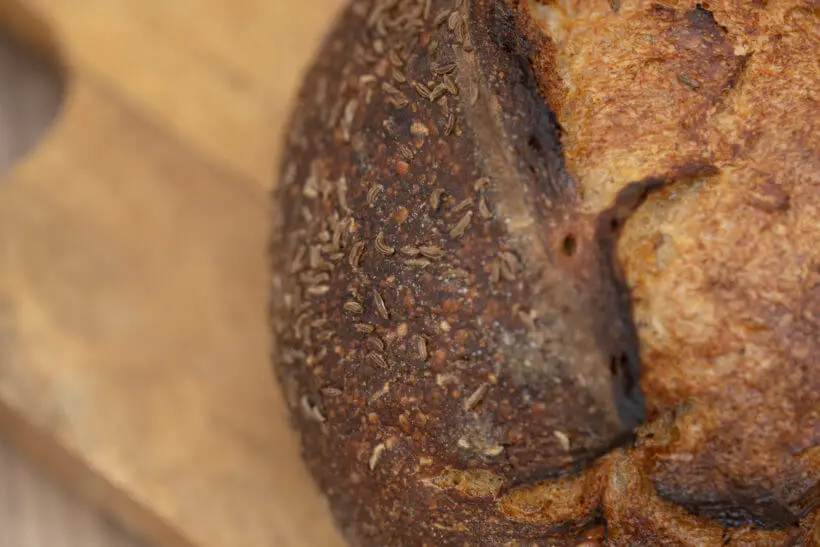
Please share this recipe for Jewish sourdough rye on social media
This is my recipe for Jewish sourdough rye. If you like the recipe, please consider sharing it with like-minded bread lovers on social media.
If you make it and post it on Instagram, please tag me as @foodgeek.dk so I can see it. That would make me very happy.
Ad links! The links for equipment and ingredients in this recipe are affiliate links, which means I will receive a commission if you purchase the product.
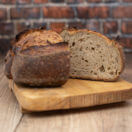
Jewish Sourdough Rye
Equipment
Ingredients
Dough
- 520 g bread flour
- 200 g light or white rye flour
- 80 g dark rye flour
- 536 g water
- 160 g sourdough starter fed and grown to its peak
- 20 g barley malt syrup
- 16 g salt
- 10 g caraway seeds
Topping
- caraway seeds as needed
Instructions
Mix dough
- To a medium bowl add: 520 grams of bread flour, 200 grams of light or white rye flour, 80 grams of whole-grain rye flour, 16 grams of salt, and 10 grams of caraway seeds.520 g bread flour, 200 g light or white rye flour, 80 g dark rye flour, 16 g salt, 10 g caraway seeds
- Mix it so that everything is well distributed.
- Then add: 160 grams of sourdough starter, 20 grams of barley malt syrup, and 536 grams of water.160 g sourdough starter, 20 g barley malt syrup, 536 g water
- You may want to reserve 50 grams of water if your bread flour isn’t very absorbent.
- For the right consistency, watch the video. Scrape down the sides of the bowl and cover the bowl.
- Leave the dough to rest for an hour to develop the gluten.
Bulk fermentation
- Do three sets of stretch and fold spaced out by 30 minutes.
- Check the gluten development by pulling a windowpane. If it fails, rest for another 30 minutes, perform a fold, and then go on.
- Put it in a see-through bulking container with straight sides, and level the top of the dough.
- Mark the top of the dough on the container and where it will have grown 25%.
- Put the dough in your proofer or somewhere warm until it’s grown 25%.
Dividing and shaping
- Drop the dough out onto the kitchen counter and divide the dough into two equally sized pieces.
- Shape each piece into a ball, and let them rest on the kitchen counter for 20 minutes to relax the gluten.
- Final-shape into your prefered shape and sprinkle the top with caraway seeds.caraway seeds
- Put the shaped doughs into bannetons and put them in the fridge. For at least 8 hours, up to 48 hours.
Baking
- An hour before you want to bake, load a baking steel or baking stone into your oven. Add a dutch oven and heat the oven to 260°C/500°F.
- When the oven is heated for an hour, grab the dough from the fridge.
- Dust it with rice flour to help it slide off the peel easily, and flip it onto the peel.
- Score the dough using a lame, then add the dough to the dutch oven.
- Put the lid on top, and bake for 20 minutes.
- Then take off the lid, lower the temperature to 230°C/450°F, and bake for 25 minutes.
- Then take out the bread, and put it on a wire rack to cool off completely.
- Bake the other bread the same way.




